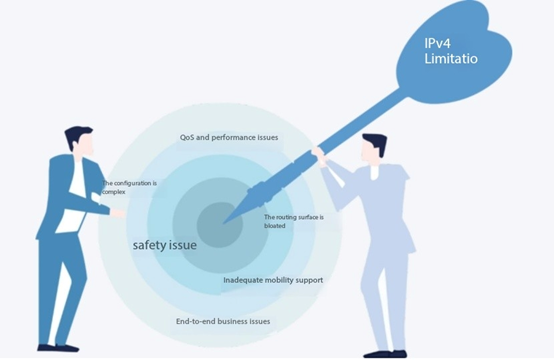Isn't it! IPv4 is not enough? Why is no one using IPV6?
Good evening, my friends
Gentlemen,IPv4The address is nearing bottom,IPv6Why don't youstick up?
Good evening, fellow web workers! We all know that,IPv4The address is like a limited-edition sneakers and is about to be snapped up. andIPv6Well, as the world's recognized savior of the next generation of the Internet, it's supposed to be long overdue.CIt's a pioneer, but why is it still tepid? No one uses it? This question has caused a lot of people to worry lately, so let's talk about it today!
If you want to get more information, scan the QR code below to contact customer service.

That's all.IPv6Let's tell you its name first.origin.. i was really confused at first,IPv4Because it's represented in four bytes.32Sir, that's a common sense.IPv6Why should we call it that?IP16Oh? It turns out that this is just a protocol version number.

InIPv4Before,IPv1、IPv2andIPv3Specially used for research.IPThe agreement was only later reached.IPv4Replace it. The last century80There's still an age out there.IPv5 Proposal to optimize real time communication, and as a result,IPv6As soon as it appears,just take it.IPv5The spotlight is on,IPv6It became the Internet protocol number one.6Version. And then someone else tried to do this.IPv7、IPv8But most of them died or were put on hold.

IPv6andIPv4The biggest difference in comparison is the addressing scheme.IPv4use32Bit address,IPv6Upgrade directly to128Hey, this gap isn't a star and a half! andIPv6There are also many unique skills:
Skill 1: There are no subnet masks and the address structure is super simple
InIPv6Ri, though, supports it, too.CIDRBut from a user's point ofview, the address structure is like dividing a house into two parts, the first part being a global Internet address and the secondpart being local.
When you view yourself on a websiteIPv6Address. You might see a line of images“1111:2222:3333:4444:5555:6666:7777:8888”The number is. Actually yours.ISPAll I know is prefixes.“1111:2222:3333:4444”And take this./ 64The address block will be given to you, and the next section will be your device's unique ID number.
Skill 2: Say GoodbyeNAT technology, equipment directly connected to the world
InIPv6In the world,NATNone of them are officially certified! In theory, each device can have a unique globally accessible address. Maybe someone would think, gone.NATWhat about device security?
actuallyNATIt wasn't supposed to be an absolute security barrier,either.IPv6Under the environment, as long as the router is set up and does not forward external connections at will, the securityis still guaranteed.
And there's that.IPv6The address does not need to be bypasse by the router and does not have to be configured specificallyVPNYou can access your local network device directly, but you have to go through authentication first! Of course, this also raises a privacy issue, and now the operating system has made a temporary arrangement.IPv6The address, change regularly to protect your privacy.
Skill 3: Automatically Configure Addresses
IPv6The device doesn't depend on it at all.DHCPThe server doesn't need to be configured manually, you can do it yourself.IPThe address! It depends onSLAACProtocol: The operating system first randomly generates one.64Bit device identifier, plus prefixes for local use onlyfe80Get a temporary address.
The device then checks whether the address is duplicated with someone else, and without a problem, asks the router for the actual prefix. After the router replies, the new address is in hand!This is very user-friendly for large networks and saves a lot of management effort.

But, about that.IPv6There are also many exaggerated claims:
Version 1 :One ofIPv6The address is all over the world.: Sorry!There will be several devices depending on different needs.IPv6addresses, such as link local addresses, public network permanent addresses, temporary addresses, and so on.
Version 2 :Assigning addresses to every atom in the universe: Ithink so much!IPv6Although the address space is large, it is notnearly enough to allocate atoms to the universe, but it is more than enough to assign an address to every grain of sand onEarth.
Option 3 :Automatic universal connection of equipment: Don't dream! Even if there isn't.NATBy default, the router still blocks external connections, and the application still has to cooperate with the protocol to allow the device to be accessed externally.
Actually,IPv6There are also quite a few "grooves":
rely onISPGraphing molecular networks:Many AmericansISPOnly forward one to the router./ 64For a prefix, routers can't partition their own networks. If you want to divide, you have to ask.ISPGive a shorter prefix, and maybe you'll have to pay more. Although Europe has a proposal, but in America it is difficult to achieve, manual configuration is too cumbersome.
The address is atURIAdditional coding is required. :Access in the browserIPv4The address is convenient and accessible.IPv6The address needs to be put in square brackets and formatted like "http://[aaaa:bbbb:cccc:dddd:eeee:ffff:1111:2222]/path/?query”Oh,i'm really in trouble!
The address is too hard to remember.:IPv6The addresses arelong and complex, and decimal numbers are much harder to remember than decimal ones, even if there are.mDNS Help, and it's not particularly reliable.
The form of address representation is too complex:IPv6Address zero values can be omitted, replaced with double apostrophes, and specified areas.IDI can even say thatIPv4Addresses. The rules are so big that entering an address in the address bar is like writing a password.
There are no visible benefits to end users:AlthoughIPv6There are advantages in theory, butIPv4You can do anything to it,IPv6The improvements brought about were not sufficiently obvious, and users could not feel them, and naturally they would not actively change.
For more IPV4 and IPV6 resources, follow the Facebook account & youtu be account: Thinkmo Dumps


